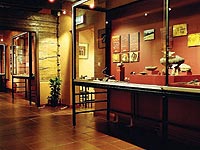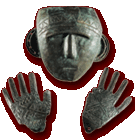 |
| Museum Großklein -
Regional Museum for Archaeology in South Styria |
| |
 The
museum, previously a cowshed, opened in 1990; an annex was constructed
between 1999 and 2003, extending the building´s capacities.
Visitors can now choose betwenn two newly adapted permanent
exhibitions, arranged and curated by Gerlinde Vanic and the
archaeologist Christoph Gutjahr. The
museum, previously a cowshed, opened in 1990; an annex was constructed
between 1999 and 2003, extending the building´s capacities.
Visitors can now choose betwenn two newly adapted permanent
exhibitions, arranged and curated by Gerlinde Vanic and the
archaeologist Christoph Gutjahr.
The exhibition "Earth - Fire - Iron. If Graves Could Speak..."
provides a historical overview of the Großklein region,
covering five and a half millennia, and presenting archaeological
discoveries and scientific findings. It emphasizes the Hallstatt
era (old Iron Age, 800 to 450 B.C.). A second exhibition titled
"From Stone Hand Axe to Iron Axe. 2000.000 Years of Tools
History" is dedicated to the development of tool technology
from the early Stone Age to the Iron Age.
The Museum Großklein is also responsible for the construction
and the maintenance of an authentically rebuilt Hallstatt era
farmstead on Burgstallkogel hill, along the archaeological trail. |
| |
|
|
| |
Prehistoric Sattlement and the Sulmtal
Necropolis
 On
Burgstallkogel hill (458 m), next to the village of Kleinklein,
archaeologists discovered an extensive settlement (approximately
50.000 square meters), dating from the late Urnfield an Hallstatt
era, that constituted one of the most important political and
economic centres of the Alpine region in early Iron Age (8.
- early 6. cent. B.C.). Its significance was strengthened by
the four exeptionally richly equipped so-calles princely tombs,
found in Saggau valley, next to Kleinklein. At Kröll-Schmiedkogel
hill, a bronze face mask, bronze hand masks, a bronze bell-shaped
armour and a bronze double-lined helmet were excavated. Today,
these items are exhibited at the Landesmuseum Joanneum in Eggenberg
castle in Graz. On
Burgstallkogel hill (458 m), next to the village of Kleinklein,
archaeologists discovered an extensive settlement (approximately
50.000 square meters), dating from the late Urnfield an Hallstatt
era, that constituted one of the most important political and
economic centres of the Alpine region in early Iron Age (8.
- early 6. cent. B.C.). Its significance was strengthened by
the four exeptionally richly equipped so-calles princely tombs,
found in Saggau valley, next to Kleinklein. At Kröll-Schmiedkogel
hill, a bronze face mask, bronze hand masks, a bronze bell-shaped
armour and a bronze double-lined helmet were excavated. Today,
these items are exhibited at the Landesmuseum Joanneum in Eggenberg
castle in Graz.
In 1982 and 1984, archaeologists found many housing foundations,
cooking places and rubbish pits on the hilltop and northern
slope of Burgstallkogel hill, thus proving that many people
had lived in close quarters. Around this prehistorical settlement
on Burgstallkogel hill, the socalled Sulmtal necropolis is located,
one of the largest and most important burial grounds from the
Hallstatt era in Europe, with some findings dating back to the
late Urnfield era. There were approximately 2000 grave mounds,
of which around 700 can still be seen today. |
| |
|
|
| |
In the Sulmtal necropolis, people were always cremated. Unfortunately,
many burial sites were plundered by dilettante grave robbers,
thereby destroying priceless archaeological and historical information.
An archaeological hiking trail with information points leads
through the early Iron Age settlement area and several groups
of grave mounds on Burgstallkogel hill. An authentically reconstructed
farmstead on Burgstallkogel hill (living quarter, weaving hut,
storehouse, breadbaking hut) impressively illustrates everyday
life in the Hallstatt era. The trail is part of the Nature Park
"Südsteirisches Weinland", connecting the villages
of Großklein and Gleinstätten.
Open the door to history! Enter the world of the Hallstatt era,
and feel the mysteries of the Iron Age!
We wish you great pleasure venturing to times long past! |
|
 |
|
